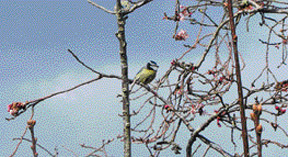| Dalkey Tidy Towns |
  |
| Dalkey Tidy Towns |
  |
Wildlife
Newsletter for the Township of Dalkey May 2010 - Michael Ryan |
 |
| Blackbird
Singing |
|
arrival.
As we came to the end of the path, yes, there was another one singing. I’ve
no doubt they’d only arrived within the previous 24 hours on the strong
southerly winds. Hope the weather stays nice for them. And for us of course!
As part of the effort to preserve Killiney and Dalkey hill’s small population
of red squirrels the parks department acquired two handmade Red Squirrel wire
feeder cages to supplement the squirrels’ diet. These cages are specifically
designed so red squirrels can enter them but the entrance is made too small
for the bigger grey squirrel to get in at the food. Two areas where reds are
regularly seen were chosen. The cages arrived and both were put up. There’s
always a risk putting up anything in the woods because of the level of anti
social behaviour at night and at the weekends but it was decided it was worth
the risk. Supplementary feeding has been very valuable in other projects where
red populations have expanded. Red Squirrels actually have more natural food
available in winter when all the conifers seeds are on the trees and in spring
when they feed on new buds and bulbs and food provided for them, hazel nuts
and maize, can be very valuable in late summer. Unfortunately, worst fears
were realised a few days later when I got a text to say that one cage put
up had disappeared the following day, even though it was tied tightly well
above head height on a tree. Very disheartening initially although a few days
later someone found the feeder thrown into bushes and returned it to park
staff. It’s been put up again in a hopefully- more inaccessible position.
|
| Feeding birds all through the year can be of great help to them but never put out loose peanuts, dry hard foods, and large chunks of bread or fats during the spring or summer. These foods can be harmful to nestlings. But peanuts and sunflower seeds in wire or plastic feeders can be of great help to adult birds. They can keep themselves well fed while they hunt for insects and other suitable food for their chicks. Last year in June our Blue Tits left the nest just as the weather turned horrible, cold and wet. We saw the parent birds feeding them later with food they were taking from the feeders. Once they’re old enough to fly they can eat the same food as their parents. Water is very important to birds especially for keeping their feathers in good condition. If you don’t have a bird bath a upturned dustbin lid or even a big plate will do. Make sure the water isn’t too deep or tilt the lid or dish slightly so the bird can wade in. |  Blue
Tit on cherry tree Blue
Tit on cherry tree |